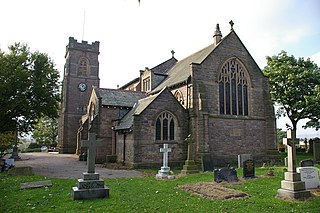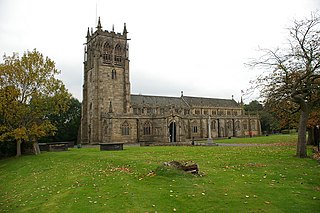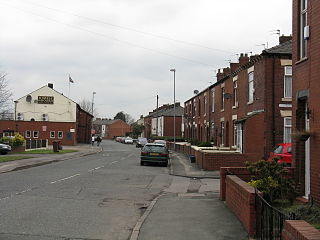
Chadderton is a town in the Metropolitan Borough of Oldham, Greater Manchester, England, on the River Irk and Rochdale Canal. It is located in the foothills of the Pennines, 1 mile (1.6 km) west of Oldham, 5 miles (8.0 km) south of Rochdale and 6 miles (9.7 km) north-east of Manchester.
Glodwick is an area of Oldham, Greater Manchester, England. It is south-east of Oldham town centre.

Middleton is a town in the Metropolitan Borough of Rochdale, Greater Manchester, England, on the River Irk. It is 5 miles (8.0 km) southwest of Rochdale and 5 miles (8.0 km) northeast of Manchester. Middleton had a population of 42,972 at the 2011 Census. It lies on the northern edge of Manchester, with Blackley to the south and Moston to the south east.

Royton is a town in the Metropolitan Borough of Oldham, Greater Manchester, England, with a population of 21,284 in 2011. Close to the source of the River Irk, near undulating land at the foothills of the South Pennines, it is 2 miles (3.2 km) northwest of Oldham, 3 miles (4.8 km) southeast of Rochdale and 8 miles (12.9 km) northeast of Manchester.

Hollinwood is an area and electoral ward of the Metropolitan Borough of Oldham, Greater Manchester, England. The population at the 2011 census was 10,920.

Shaw and Crompton is a civil parish in the Metropolitan Borough of Oldham, Greater Manchester, England, and lies on the River Beal at the foothills of the South Pennines. It is located 2 miles (3.2 km) north of Oldham, 4 miles (6.4 km) south-east of Rochdale and 9 miles (14 km) north-east of Manchester. Its largest settlement is Shaw.

Thornham is a suburban area straddling Middleton, Royton and Rochdale in Greater Manchester, England. The area crosses the border of the Metropolitan Borough of Oldham and the Metropolitan Borough of Rochdale and is divided at a constituency and electoral ward level.

Oldham was, from 1849 to 1974, a local government district in the northwest of England coterminous with the town of Oldham.

Coldhurst is an area of Oldham and an electoral ward of the wider Metropolitan Borough of Oldham in Greater Manchester, England. At the time of the United Kingdom Census 2001, it had a population of 11,935, increasing to 13,201 at the 2011 Census. The electoral ward spans most of Oldham's town centre, although the name Coldhurst conventionally applies to the area immediately north of the centre. The district of Westwood and a small adjoining part of Chadderton in the Busk area also lie within the Coldhurst ward district.

Werneth is an area of Oldham, Greater Manchester, England. The population at the 2011 census was 12,348. It is 1 mile (1.6 km) west-southwest of Oldham's commercial centre and one of its most ancient localities. It is contiguous with Westwood, Hollinwood, Hollins and Chadderton. Werneth includes Freehold between Werneth Park and Oldham's border with Chadderton at Block Lane.
Prestwich was a constituency in the county of Lancashire of the House of Commons for the Parliament of the United Kingdom. Created by the Redistribution of Seats Act 1885, it was represented by one Member of Parliament. The constituency was abolished in 1918.

Royton was a local government district from 1863 to 1974 in Lancashire, England, which covered the modern-day town of Royton, and its suburbs and districts.

Waterhead, is an area of Oldham, and an electoral ward of the Metropolitan Borough of Oldham, in Greater Manchester, England. Historically in Lancashire, an upland area in the Pennines, the ward of Waterhead has population of 12,876, decreasing to 12,029 at the 2011 Census.

Rochdale was an ecclesiastical parish of early-medieval origin in northern England, administered from the Church of St Chad, Rochdale. At its zenith, it occupied 58,620 acres (237 km2) of land amongst the South Pennines, and straddled the historic county boundary between Lancashire and the West Riding of Yorkshire. To the north and north-west was the parish of Whalley; to the southwest was the parish of Bury; to the south was Middleton and Prestwich-cum-Oldham.

Sholver is an area of Oldham, in Greater Manchester, England. An elevated, residential area, it lies near the middle of the Oldham part of the valley of the River Beal, 2.1 miles (3.4 km) northeast of Oldham's commercial centre, nearly at the northeasternmost extremity of the town, by open countryside close to the source of the River Medlock and by the border with Saddleworth.

The Church of St Mary with St Peter, commonly known as Oldham Parish Church, is the Church of England parish church of Oldham in Greater Manchester, England. It forms part of the Diocese of Manchester, and is a grade II* listed building.

Nimble Nook is a locality in the town of Chadderton in the Metropolitan Borough of Oldham, Greater Manchester.

Tonge is a residential and industrial area of Middleton, in the Metropolitan Borough of Rochdale, Greater Manchester. It lies on the east side of Middleton between the town centre and its border with Chadderton in the Metropolitan Borough of Oldham.

















